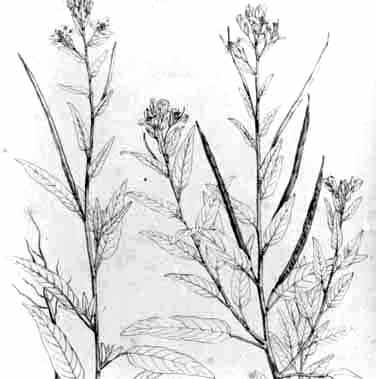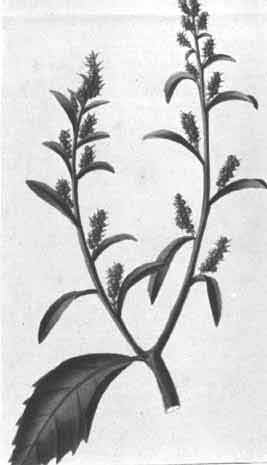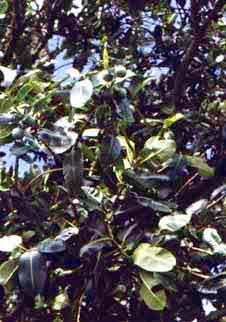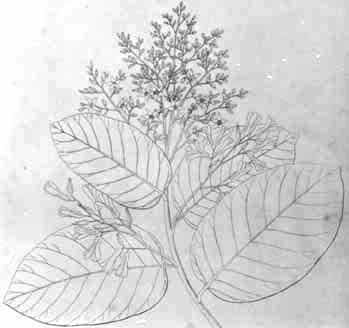CHAPTER 3b: ALPHABETICAL LIST OF PLANT FAMILIES
WITH INSECTICIDAL AND FUNGICIDAL PROPERTIES
| Contents
- |
| BRASSICACEAE (CRUCIFERAE)
Raphanus sativus L. (Radish, Rave, Karad)
|
|
Rehm and Espig, 1991 |
| Description
|
Perennial plant up to 1.5 m high with fleshy branched root up to 60 cm long and 5 cm thick. Radical leaves large (30-100 cm long), lanceolate with dentate margins and long petioles. Stem leaves shortly petiolate and variable in shape, the lower ones lobed or almost pinnate, the upper ones entire. | Flück, 1976
|
| Habitat | Widely cultivated. | Rehm and Espig, 1991 |
| Uses | Cultivated for human consumption and as animal fodder. | Rehm and Espig, 1991 |
| Oil | 3 ml/kg admixed with wheat caused 100 percent mortality in adult S. oryzae within 72 hours and significantly reduced the extent of damage caused by the F1 generation. | Pal, et al. 1988 |
| Seed viability | 3 ml/kg admixed with wheat did not reduce seed germination after an exposure period of 45 days. | Pal, et al. 1988 |
| Constituents | Include: alkaloid spirobrassinin. | Southon and Buckingham, 1988 |
| CAESALPINIACEAE
Erythrophleum suaveolens (Guill & Perr.) Brenam (Ordeal tree, Red water tree)
|
Photograph unavailable |
Niber, et al. 1992 |
| Description | Tree up to 30 m tall with spreading crown; rough bark. Leaves twice pinnate; individual leaflets in 7-13 pairs, ovate or elliptic-oblong; approx. 6-10 cm in length and 2.5-6 cm wide. Woody, black pods approx. 6-12 cm long and 2.5-4 cm in width, flat, containing 5-10 seeds. | Verdcourt and Trump, 1969 |
| Habitat | Widespread in tropical Africa. | Verdcourt and Trump, 1969 |
| Uses | Bark extract is used as an arrow poison, in folk medicine, and as a tanning agent. Timber is is hard and heavy (sinks in water); resistant to fungi and termites. | Duke, 1985 |
| Extract | Topical application of extract
to adult A. obtectus,
S. zeamais and P. truncatus significantly reduced survival. |
Niber, et al. 1992 |
| Bark | 2 g powdered bark added to 500 cowpeas reduced oviposition and egg hatch in C. maculatus. | Ofuya, 1990 |
| Constituents | Main alkaloids are cassaidine, nor-cassaidine, cassaine, cassamine, erythrophalamine, erythrophleine and homophleine. | Duke, 1985
|
| Toxicity
|
Highly toxic causing a primary slowing of the heart in humans followed by acceleration, dyspnea with laboured respiration and death due to respiratory failure. | Duke, 1985
|
| CAPPARIDACEAE
Boscia senegalensis (Pers.) Lam. ex Poir.
|
|
Seck, et al. 1993
|
| Description
|
Evergreen shrub or small tree, up to 3 m tall; often in thickets, frequently on abandoned termite mounds; large leaves up to 13 cm long; green/yellow flowers in dense clusters; globose fruit up to 1.5 cm in diameter, green, yellow/brown when mature; contain 1-2 seeds. | Burkill, 1985; Irvine, 1961
|
| Habitat | Distributed from Mauritania to Niger, northern Nigeria and north-west Cameroons, and across Africa to Sudan and Ethiopia. | Irvine, 1961 |
| Uses | Used both as a famine food and in traditional medicine. | Seck, et al. 1993 |
| Fresh ground leaves | Four percent (w/w) admixed with cowpeas caused 100 percent mortality in adult C. maculatus within 24 hours and prevented egg-laying. Admixture of fresh whole leaves and dry leaf powder was less effective. | Seck, et al. 1993 |
| Acetone extract of fruits | Acetone extract in a glass desiccator caused 100 percent mortality in adult S. cereallela within 1.5 hours, the LT50 values for C. maculatus and P. truncatus were 2.3 hours and 3.8 hours respectively. | Seck, et al. 1993 |
| Constituents
|
Include: methyl isothiocyanate
which is liberated from a glucosinolate precursor; glucocapparin found in
the fruits and leaves.
Also contains trans-2-hexenal and methyl-cyanide (liberated from glucocapparin). L-stachydrine and 3-hydroxystachydine (alkaloids) are also reported to be present in leaves. |
Seck, et al. 1993
Lognay, et al. 1994 Southon and Buckingham, 1988 |
| CAPPARIDACEAE
Cleome monophylla L.
|
 |
Daziel, 1937 |
| Description | Errect, hairy, branched herb, 30-60 cm tall; leaves oblong or oblong-lanceolate or ovate-lanceolate, 2.5-5 cm long. Flowers 1.2-2.5 cm long in racemes in axils of petioled bracts. | Verma, et al. 1993 |
| Habitat | India and West Africa. | Verma, et al. 1993 |
| Uses | Used for medicinal puroses in northern Nigeria. | Ndungu, et al. 1995 |
| Essential oil | 0.1 m l of essential oil resulted in 83.4 percent repellency of adult S. zeamais. | Ndungu, et al. 1995 |
| Constituents | Essential oil contains: terpenolene
(14 percent), 1-a -terpeneol (10 percent), pentacosane
(9 percent). (a and b
)-humulene (8 percent), phytol (5 percent) and 2-dodecanone (4 percent).
0.1 m l of 2-dodecanone resulted in 78.6 percent repellancy of adult S. zeamais. |
Ndungu, et al. 1995
|
|
CELASTRACEAE Celastrus angulatus Maxim. (Chinese bittersweet)
|
Photograph unavailable |
Perry, 1980 | |
| Description | |||
| Habitat | China. | Zhang and Zhao, 1983 | |
| Uses | In China, the root bark is used as a traditional method of protecting vegetables against insects. | Zhang and Zhao, 1983 | |
| Root bark powder | Powder mixed with rice at 0.5 percent (w/w) reduced population growth in S. zeamais and S. oryzae by 90 percent by inhibiting development of eggs and young larvae. | Zhang and Zhao, 1983 | |
| It is reported to be an antifeedant and stomach poison, producing a narcotic effect in S. zeamais. An ether extract applied to rice at 2.6 mg/g completely prevented insect reproduction. The extract was found to be relatively stable in sunlight and heat. | Chui, 1989 | ||
| Constituents | At least seven sesquiterpene alkaloids and four sesquiterpene esters have been isolated and identified. They include maytansine, triptolide, maytoline and evonine. All the compounds contain a common mother nucleus-agarofuran. Celengalin is thought to be the most active compound in the root bark and seed oil. | Chiu, 1989 | |
| CHENEPODIACEA
Chenopodium ambrosioides L. (Mexican tea, American or Indian wormseed, Ambroisine, Sweet pigweed) |
 |
Rehm and Espig, 1991
Duke, 1981
|
| Description | Strong-smelling, upright annual or short-lived perennial, with oblanceolate leaves. | Bown, 1995
|
| Habitat | Temperate zones to tropical; native to Mexico. | Uphof, 1968 |
| Uses | The major use as a fragrance component
in creams, perfumes and soaps. It is also used as an anthelmintic and as
flavouring in soups.
The oil is also used in both human and veterinary medicine. In addition it has been used as a traditional protectant for stored beans and groundnuts in the congo. |
Duke, 1985
Peterson, et al. 1989 |
| Ethanol and hexane extracts of
fruits.
|
Following a 24 hour exposure on treated glass, the lc50 for t. Castaneum was 80 m g/cm squared and 55m /cm squared for s. Granarius. The compounds isolated were eicosadienoate, hexadecanoate, and dicarboxylic acid derivatives. | Peterson, et al. 1989 |
| Powder | Admixture of 25 g/kg groundnuts caused 90 percent mortality in adult C. serratus within 13 days and prevented egg-laying and f1 production. | Delobel and Malonga, 1987 |
| Petroleum ether: acetone extract of leaves. | A 1 percent solution applied to filter paper was classified as a class iii repellent (47 percent) against adult T. castaneum after an exposure period of four weeks when assessed over five days. Anti-feedant activity was assessed by counting puncture holes produced by R. dominica confined on treated filter papers for four days. One percent extract produced the same level of anti-feedant activity as an extract of Azadirachta indica (neem). | Malik and Mujtaba Naqvi, 1984 |
| Oil | Topical application of the oil at 40 m g/insect caused 100% mortality in adult C. maculatus and 50 m g/insect caused 92 percent mortality in adult L. serricorne within three days. S. oryzae and T. confusum were less susceptible; 50 m g/insect caused 52 percent and 15 percent mortality respectively. | Su, 1986 |
| Constituents | The active substance, ascaridol
is a terpenic peroxide.
Reported constituents include: volatile oil, ascaridol, geraniol, saponin, 1-limonene, p-cymene and d-camphor. Volatile compounds of the leaves include: limonene (32.5 percent) and trans-pinocarveol (26.7 percent). |
Peterson, et al. 1989
Sagrero-Nieves and Bartley, 1995 |
| Hydrocyanic acid, geraniol, myrcene,
camphor and methyl salicylate are also reported.
Oil contains: 20-30 percent of terpenoids (p-cymene, limonene, terpene) and 60-80 percent of ascaridol. |
Duke, 1985
Perry, 1980 |
|
| Toxicity | The oil is poisonous, an overdose
can be fatal. The therapeutic dose in human medicine is very close to the
minimum toxic level.
Ascaridol is toxic to cold-blooded animals. It kills and paralyses Ascaris and hookworms (Ankylostoma) and to a lesser extent oxyurides and cestodes. |
Duke, 1985
Oliver-Bever, 1986 |
| CLUSIACEAE (GUTTIFERAE)
Calophyllum inophyllgum L. (Laurelwood)
|

|
Oliver-Bever, 1986
|
| Description
|
Handsome, low-branching, crooked or leaning tree, up to 20 m in height; rough grey bark. Leaves shiny green, leathery, oblong, 8-20 cm long with yellow midrib. White, very fragrent flowers. 3 cm green fruit in pendulous clusters; thin leathery skin covering bony shell, containing a single kernal. | Graf, 1986
|
| Habitat | Native to South and East India;
introduced into West Africa.
Tolerant of saline soils. |
Oliver-Bever, 1986
Grainge and Ahmed, 1988 |
| Uses
|
All parts of the tree are used
in traditional medicine. Leaves are used as a fish poison.
Kernal oil used for lighting. |
Oliver-Bever, 1986
|
| Oil
|
5 ml/kg applied to wheat seeds prevented attack by natural infestations of insects for 12 months in a store. The oil treatment reduced infestation to 18 percent compared with 63 percent in the untreated control. | Gupta, et al.1988
|
| Seed viability | Application of the oil at 5 ml/kg reduced wheat germination by 28 percent. | Gupta, et al. 1988 |
| Constituents | Leaves contain friedelin and triterpenes canophyllol, canophyllal and canophyllic acid. Derivatives of 4-phenylcoumarin have been isolated from seeds. | Oliver-bever, 1986 |
| CONVOLVULACEAE
Convolvulus arvensis L. (Field bindweed, Cornbine) |
|
Schauenberg and Paris, 1977
|
| Description
|
A climbing or scrambling perennial. Stem may reach 60 cm in length; to climb, stems rotate in an anti-clockwise manner. Leaves sagittate; flowers trumpet-shaped, up to 3 cm in diameter, varying from pale to dark pink in colour. | Schauenberg and Paris, 1977
|
| Habitat | Throughout Europe, Western and Northern Asia. Very common in cultivated fields, on fallow land and banks. | Schauenberg and Paris, 1977 |
| Uses | The plant is used in Europe as a dressing for wounds, and as a purgative in Vietnam. | Watt and Breyer-Brandwijk, 1962 |
| Leaves
|
Ethanol extracts applied to glass produced LC50 values for T. castaneum and S. granarius of 85-1275 m g/cm2 and 55-300 m g/cm2 respectively, when the insects were confined for 24 hours on treated surface and then returned to food media; mortality was assessed at seven days. | Peterson, et al. 1989
|
| Acetone extract of seed | 600 m
g/cm2 applied to filter paper in repellency tests produced Class
IV (74 percent) repellency against
T. confusum four months after application. Topical application of 50 m g/insect caused 40 percent mortality in S. oryzae when assessed 48 hours after application; C. maculatus, L. serricorne and T. confusum were only very slightly susceptible. |
Su, 1986 |
| Constituents
|
Include: hexadecanoate, penta-,
hepta-, and nona-decanoate, octadecanoate and dicarboxylic acid derivatives.
The rhizome containes a resinous glycoside (convolvuline) and tannin. The leaves are rich in tannin but contain less of the resin. |
Peterson, et al. 1989
Schauenberg and Paris, 1977 |
| CUCURBITACEAE
Momordica charantia L. (Balsam pear, Bitter gourd, Bitter melon, African cucumber, Cerasee)
|
|
Rehm and Espig, 1991
|
| Description | Annual climber growing to about
2 m in length; deeply lobed leaves; yellow flowers and orange yellow fruit.
Leaves 3-5 foliolate; leaflets elliptic or obvate, often more or less rounded at base. Flowers subtended by large leafy orbicular toothed bract. Male flowers crowded, females solitary on long peduncles. |
Graf, 1986
Hutchinson and Dalziel, 1936 |
| Habitat | Native to Southeast Asia; widespread
in the tropics and subtropics. Cultivated in Asia.
Almost entirely wild in Africa in lowland rain forest and wooded areas; common from Senegal to West Cameroons. |
Graf, 1986; Rehm and Espig, 1991
Burkill, 1985 |
| Uses | It is eaten in Asia as a vegetable, and used as a medicinal plant in the West Indies and South America. | Rehm and Espig, 1991; Ayensu 1981 |
| Leaf powder | Two percent (w/w) admixed with wheat reduced damage by T. granarium larvae; six months after initial introduction of larvae, the observed damage was 32 percent in the treated wheat compared with 90 percent in the control. | Jood , et al. 1993 |
| Constituents |
Include: charantin, momordicin and foetidin; 5-hydroxytryptamine, diosgenin and p-sitosterol. | Oliver-Bever, 1986 |
| Toxicity: seed oil | 50 mg/kg of charantin reduces hyperglycaemia in rabbits by 42 percent. It has also shown antifertility effects in both males and females. | Oliver-Bever, 1986 |
| DIPTEROCARPACEAE
Shorea robusta Gaertn. f. (Sal tree)
|
 |
Rehm and Espig, 1990 |
| Description | Tree up to 30 m high, black, furrowed bark; young branches, petioles and inflorescence pubescent. Stipules up to 7 mm long, falcate, caducous, leaves alternate, 8-17.5 x 5-12.5 cm, ovate or ovate-oblong. Flowers cream coloured, petals up to 11 cm long. Wood dark reddish/brown, very durable, course and hard. | Verma, et al. 1993; Uphof,
1968
|
| Habitat | Widespread from the Himalayas to Punjab. | Uphof, 1968 |
| Uses | Important forest tree in South-east Asia. The tree supplies resin for paints and lacquers. The bark is used in tanning and the seeds are used for vegetable oil and press cakes. Wood of high timber value. | Rehm and Espig, 1990; Ketkar, 1987; Verma, et al. 1993 |
| Oil | 0.5 percent (w/w) applied to green gram reduced damage by C. chinensis to 1.3 percent compared to 92 percent in untreated controls, during a 90 day storage period. | Ketkar, 1987 |
| Contents
- |